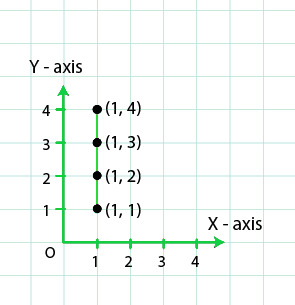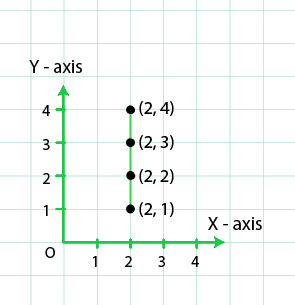问题1.绘制点(5,0),(5,1),(5,8)。他们躺在一条线上吗?你的观察是什么?
解决方案:
Initially take a point O on the graph and draw horizontal and vertical lines OX and OY.
In this graph x-axis and y axis 1 cm represents 1 unit.
First plot point (5, 0), we start from the origin O and move 5 cm along X – axis. The point is (5, 0).
Now plot point (5, 1), move 5 cm along X – axis and 1 cm along Y – axis. The point is (5, 1).
Now plot point (5, 8), move 5 cm along X – axis and 8 cm along Y – axis. The point is (5, 8).

From the above graph we observed that all points are having same X – coordinates, we can say that all points lie on a line parallel to the y-axis. Hence, all points lie on the same line.
问题2.绘制点(2,8),(7,8)和(12,8)。成对加入这些点。他们躺在一条线上吗?你观察到什么?
解决方案:
Initially take a point O on the graph and draw horizontal and vertical lines OX and OY.
In this graph x-axis and y axis 1 cm represents 1 unit.
In order to plot point (2, 8), move 2 cm along X – axis from origin O and 8 cm along Y – axis. The point we arrive at is (2, 8).
To plot point (7, 8), move 7 cm along X – axis and 8 cm along Y – axis. The point we arrive at is (7, 8).
To plot point (12, 8), move 12 cm along X – axis and 8 cm along Y – axis. The point we arrive at is (12, 8).

From the above graph, we observed that all points are having same Y – coordinates, it can be seen that the points lie on a line parallel to the x-axis. Hence, all points lie on the same line.
问题3.找到要点:
(i)(1、1),(1、2),(1、3),(1、4)
(ii)(2、1),(2、2),(2、3),(2、4)
(iii)(1、3),(2、3),(3、3),(4、3)
(iv)(1、4),(2、4),(3、4),(4、4)
解决方案:
(i) (1, 1), (1, 2), (1, 3), (1, 4)
To plot these points,
Initially take a point O on the graph and draw horizontal and vertical lines OX and OY.
In this graph x-axis and y axis 1 cm represents 1 unit.
Initially to plot point (1, 1), move 1 cm along X – axis from origin O and 1 cm along Y – axis. The point we arrive at is (1, 1).
To plot point (1, 2), move 1 cm along X – axis and 2 cm along Y – axis. The point we arrive at is (1, 2).
To plot point (1, 3), move 1 cm along X – axis and 3 cm along Y – axis. The point we arrive at is (1, 3).
To plot point (1, 4), move 1 cm along X – axis and 4 cm along Y – axis. The point we arrive at is (1, 4)

(ii)(2、1),(2、2),(2、3),(2、4)
To plot these points,
Initially take a point O on the graph and draw horizontal and vertical lines OX and OY.
In this graph x-axis and y axis 1 cm represents 1 unit.
Initially plot point (2, 1), move 2 cm along X – axis and 1 cm along Y – axis. The point we arrive at is (2, 1).
To plot point (2, 2), move 2 cm along X – axis and 2 cm along Y – axis. The point we arrive at is (2, 2).
To plot point (2, 3), move 2 cm along X – axis and 3 cm along Y – axis. The point we arrive at is (2, 3).
To plot point (2, 4), move 2 cm along X – axis and 4 cm along Y – axis. The point we arrive at is (2, 4).

(iii)(1、3),(2、3),(3、3),(4、3)
To plot these points,
Initially take a point O on the graph and draw horizontal and vertical lines OX and OY.
In this graph x-axis and y axis 1 cm represents 1 unit.
Initially plot point (1, 3), move 1 cm along X – axis and 3 cm along Y – axis. The point we arrive at is (1, 3).
To plot point (2, 3), move 2 cm along X – axis and 3 cm along Y – axis. The point we arrive at is (2, 3).
To plot point (3, 3), move 3 cm along X – axis and 3 cm along Y – axis. The point we arrive at is (3, 3).
To plot point (4, 3), move 4 0cm along X – axis and 3 cm along Y – axis. The point we arrive at is (4, 3).

(iv)(1、4),(2、4),(3、4),(4、4)
To plot these points,
Initially take a point O on the graph and draw horizontal and vertical lines OX and OY.
In this graph x-axis and y axis 1 cm represents 1 unit.
In order to plot point (1, 4), move 1 cm along X – axis and 4 cm along Y – axis. The point we arrive at is (1, 4).
To plot point (2, 4), move 2 cm along X – axis and 4 cm along Y – axis. The point we arrive at is (2, 4).
To plot point (3, 4), move 3 cm along X – axis and 4 cm along Y- axis. The point we arrive at is (3, 4).
To plot point (4, 4), move 4 cm along X – axis and 4 cm along Y – axis. The point we arrive at is (4, 4).

问题4.找到点A,B,C,D的坐标。

解决方案:

Initially draw perpendiculars AP, BP, CQ and DR from A, B, C and D on the x-axis. Also, draw perpendiculars AW, BX, CY and DZ on the y-axis.
From the above figure we have observed that,
AW = 1 unit and AP= 1 unit
Therefore the coordinates of vertex A are (1, 1).
Similarly, BX=1 unit and BP= 4 units
Hence, the coordinates of vertex B are (1, 4).
CY = 4 units and CQ= 6 units
Therefore, the coordinates of vertex C are (4, 6).
DZ = 5 units and DR= 3 units
Hence, the coordinates of vertex D are (5, 3).
问题5.找到点P,Q,R和S的坐标。

解决方案:

Initially draw perpendiculars PA, QB, RC and SD from vertices P, Q, R and S on the X – axis and draw perpendiculars PE, QF, RG, and SH on the Y – axis from these points.
PE = 10 units and PA = 70 units
therefore, the coordinates of vertex P are (10, 70).
QF = 12 units and QB = 80 units
therefore, the coordinates of vertex Q are (12, 80).
RG = 16 units and RC = 100 units
therefore, the coordinates of vertex R are (16, 100).
SH = 20 units and SD = 120 units
therefore, the coordinates of vertex S are (20, 120).
问题6.写下每个多边形的每个顶点的坐标。

解决方案:

From the figure, we have observed that,
In Quadrilateral OXYZ,
O lies on the origin and the coordinates of the origin are (0, 0). So, the coordinates of O are (0, 0).
X lies on the Y – axis. So, the X – coordinate is 0. Hence, the coordinate of X is (0, 2).
YX is equal to 2 units and YZ is equal to 2 units. So, the coordinates of vertex Y are (2, 2).
Z lies on the X – axis. So, the Y – coordinate is 0. Hence, the coordinates of Z are (2, 0).
In polygon ABCD,
Draw perpendiculars DG, AH, CI and BJ from A, B, C and D on the X – axis.
Also, draw perpendiculars DF, AE, CF and BE from A, B, C and D on the Y – axis.
Now, from the figure we observed that,
DF = 3 units and DG = 3 units
Therefore, the coordinates of D are (3, 3).
AE = 4 units and AH = 5 units
Therefore, the coordinates of A are (4, 5).
CF = 6 units and CI = 3 units
Therefore, the coordinates of C are (6, 3).
BE = 7 units and BJ = 5 units
Therefore, the coordinates of B are (7, 5).
In polygon PQR,
Draw perpendiculars PJ, QK and RK from P, Q and R on the X – axis and draw perpendiculars PW, QE and RF from P, Q and R on the Y – axis.
Now, from the figure observed that,
PW = 7 units and PJ = 4 units
Therefore, the coordinates of P are (7, 4).
QE = 9 units and QK = 5 units
Therefore, the coordinates of Q are (9, 5).
RF = 9 units and RK = 3 units
Therefore, the coordinates of R are (9, 3)
问题7.确定以下哪个陈述是正确的,哪个是错误的。解释你的回答。
(i)x坐标为零的点将位于y轴上。
(ii)y坐标为零的点将位于x轴上。
(iii)原点的坐标为(0,0)。
(iv)x和y坐标相等的点位于通过原点的线上。
解决方案:
(i) A point whose x-coordinate is zero, will lie on the y-axis.

From the figure we observed that,
For x = 0, we have x- coordinates as zero.
For example (0, 3), (0, 6), (0, 9)
These points will lie on y axis. Therefore we say that our given statement is true.
(ii) A point whose y-coordinate is zero, will lie on x-axis.

A point whose y-coordinate is zero, will lie on x-axis.
For y = 0, we have y- coordinates as zero.
For example (3, 0), (6, 0), (9, 0)
These points will lie on x axis. Therefore we say that our given statement is true.
(iii) The coordinates of the origin are (0, 0).
Origin is intersection of x-axis and y-axis. This means that coordinates of the origin will be intersection of lines y = 0 and x = 0.
Hence, coordinates of origin are (0, 0).
Therefore given statement is true.
(iv) Points whose x and y coordinates (0, 0), (1, 1), (2, 2) etc are equal, lie on a line passing through the origin.
For above statement we can conclude that our statement satisfies the equation x = y.
For x = 0 and y = 0, this equation gets satisfied.
Therefore given statement is true.